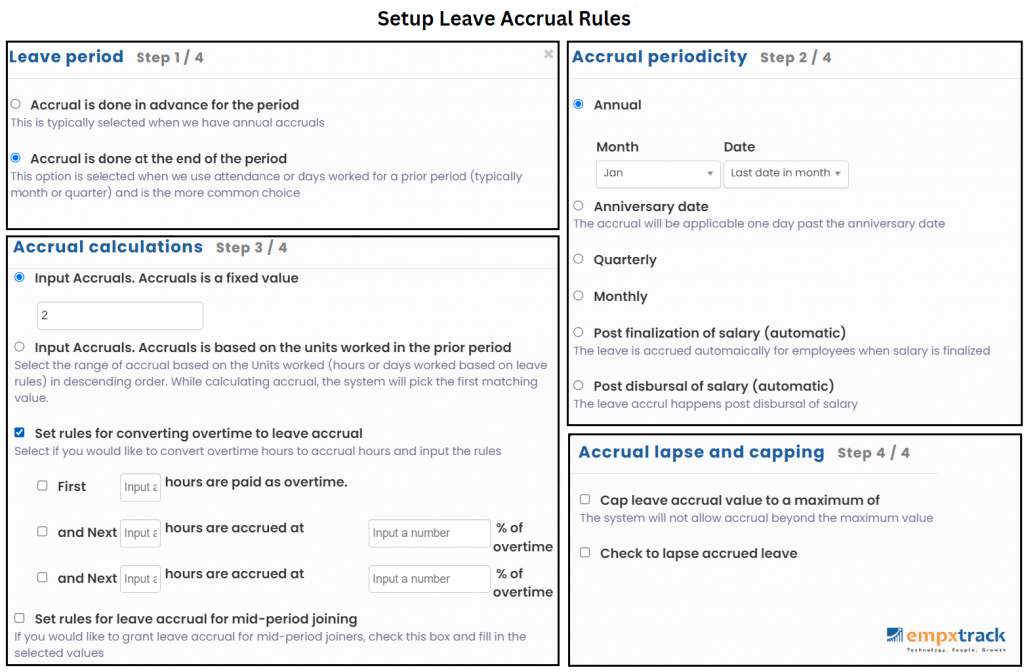This article explains the significance of paid time off, the different PTO models and provides insights into how to calculate PTO accrual. We’ll also dive into PTO accrual rates, ensuring you understand how employees accumulate time off.
Using this guide, you’ll be able to design a PTO policy that keeps your employees happy and productive!
Table of Contents
Significance of Paid Time Off (PTO)
Paid Time Off allows employees to take time off from work while still receiving their regular pay. In other words, PTO is also called paid leave. PTO can be accumulated based on hours or days worked by an employee.
PTO can include vacation days, sick leave, maternity or paternity leave, and other types of paid leave applicable as per laws such as Jury duty.
The paid time off rules vary based on company policies, industry norms, local legal requirements, and employment agreements.
Nearly a third (31%) of employees report mandatory paid time off as a top benefit.
Some companies encourage employees to take periodic time off to reduce burnout and stress, and ensure work life balance. Such companies have higher productivity and employee satisfaction.
What is PTO Accrual?
PTO accrual or paid time off accruals is the process of accumulating paid leave that can be utilized by the employee later. It is based on factors such as time worked, tenure, company policies, local regulations, and in some cases even employment agreements.
For example, an employee might accrue one hour of PTO for every 40 hours (1 week) worked. An employee who works the entire year will be eligible for 52 hours of paid time off at the end of the year.
The process to calculate PTO accrual and manage vacation time can be a daunting task for employers and employees alike.
Let’s explain a few important terms related to PTO accrual before moving forward.

PTO Accrual Rate
The PTO accrual rate determines how employees earn paid time off, whether it’s based on hours worked or years of service.
Companies may choose to provide PTO as a lump sum each year or allow it to build up gradually over time.
For example, let’s say your company’s accrual rate is 0.0833 PTO hours for every hour worked. This means for every 12 hours worked, you earn one hour of PTO.
So, if you work a regular full-time (48 hours per week, or 8 hours daily for 6 days a week) schedule, you will earn PTO for a day off every couple of weeks.
Accrual Frequency
Accrual frequency determines how frequently employees can earn their PTO.
Common frequencies to calculate PTO accruals include weekly, bi-weekly, semi-monthly, monthly, or annually and may be done at the end of each pay period.
Accruals can also be granted at the beginning of an accrual period, say the start of the year. This allows employees to plan their vacation time.
PTO Accrual Caps and Limits
PTO accrual caps and limits refer to the maximum amount of paid time off that employees can accumulate. Any additional accrued time is either paid or ignored.
For operational reasons, companies may not want employees to be unavailable for long periods of time. Hence accrual limits (or caps) are defined in company policies. This policy encourages employees to take periodic time off.
For example, let’s consider an employee Sarah who is a senior manager. The maximum PTO accrual cap for senior employees like Sarah is 120 hours (or 3 weeks) per calendar year.
This means Sarah cannot accrue more than 120 hours of PTO at any given time.
Now, suppose Sarah has already accrued 120 hours of PTO over the past year. Since she has reached the accrual cap, she must utilize some of her accrued PTO before she can accumulate more. This means she will have to take some paid time off – and this encourages people to relax and take care of their personal needs.
PTO Payouts
One way that accrued PTO can benefit employees is through PTO payouts.
At the end of the year, employees might either carry unused accrued PTO into the new year or cash it out at their usual pay rate.
However, PTO accrual caps may limit the number of hours an employee can accumulate, affecting their potential payout and carryover.
An exiting employee receives PTO payouts for unused paid time off that they have accumulated but not utilised.
However, it’s essential to note that specific payout policies may vary based on policies, employment contracts, and applicable laws and regulations.
Factors Influencing PTO Accrual
Tenure Based Accrual
Many companies offer PTO accrual rates that increase with an employee’s tenure. As a result, this encourages employees to remain with the company and rewards their loyalty with additional PTO benefits.
According to SHRM, the average PTO accrual rate for employees with less than one year of service is around 4.5 hours per pay period. On the other hand, employees with five years or more of service might accrue closer to 6.5 hours per pay period.
Employment Status Based Accrual
Employees are entitled to vacation time based on their employment status and the number of hours worked.
According to the U.S. Bureau of Labor Statistics (BLS), full-time employees in private industry receive an average of 10 paid vacation days after one year of service. This increases to an average of 15 days after five years.
Company Policies
Each organization establishes its own PTO accrual policies. This may vary widely depending on industry norms, company culture, and competitive positioning. Based on these policies, an employer decides accrual rates, eligibility criteria, carryover provisions, and other relevant guidelines.
Different Types of PTO Models
| Type of PTO Models | ||||
|---|---|---|---|---|
| Fixed Annual PTO | Lump Sum PTO | Unlimited PTO | Flexible Time Off | |
| Accrued over time based on days or hours worked | PTO given at the start of the time period | Fully paid leave without specifying any number of days | Leave days are not assigned. Instead, employees have the freedom to take time off as needed with approval | |
| Limit on carryover | May or may not carryover, as per company policy | Not applicable | Depending upon company policy | |
| Majority of companies pay for unused accrued leave | May not payout for unused accrued leave, depending upon company policy | No payout | May not payout for unused accrued leave, depending upon company policy | |
What is Vacation Time? How is it Different from Paid Time Off?
The terms PTO and vacation are often used interchangeably, but they’re not the same thing. Paid time off (PTO) is a broader category that encompasses various types of leave, including vacation time, sick leave, maternity or paternity leave, personal days, and other forms of paid leave.
In other words, one can say that all vacation is PTO whereas all PTO is not vacation.
Vacation time specifically refers to leave granted to employees for the purpose of taking a break from work.

Employers may require advance notice or approval for the use of vacation time, depending on company policies and staffing needs.
As per a report by Forbes, “Over 765 million vacation days have gone unused by Americans”. Many American workers have vacation days meant for relaxation, yet not all employees use them.
Reasons vary from forgetting or not wanting to use them because of internal competition, managers discouraging leave, or having too much to do.
How to Calculate PTO Accruals?
Modern HR solutions play a vital role in effortlessly managing PTO accruals and vacation time.
Empxtrack, a leading cloud-based leave management solution seamlessly manages all stages of the employee’s leave management process.
This includes employees’ leave applications, leave balance and accruals, leave data analysis, auto credit of leave, company specific leave rules and policies.

Learn how to manage and calculate PTO accruals using Empxtrack:
- Configure Leave Types: Configure different leave types, including vacation time, sick leave, personal days, and any other types of paid time off your organization offers. These leave types can be created for different groups as well.
- Credit Leave: Empxtrack offers multiple leave credit methods, including manual and auto. Use a scheduler for leave accrual. Set up a scheduler in four steps, as shown in the image above. Leave credit rules can be configured for each leave type.
- Configure PTO Accrual Rules: Configure accrual rules to align with your company’s PTO policies. Specify the accrual rates for each leave type, the frequency of accruals, and any accrual caps or limits.
Accrual frequency can be monthly, quarterly, annually, based on work anniversary date, and post finalization or disbursal of salary. - Monitor Accrual Balances: Regularly monitor employees’ PTO accrual balances using Empxtrack’s reporting and analytics tools. This subsequently allows you to track accruals in real-time and identify any discrepancies or issues that need to be addressed.
- Calculate PTO Accruals: It can be a fixed value or based on units worked in a specific time period. Get the flexibility to convert overtime to leave accrual.
Utilize Empxtrack’s automation capabilities to calculate PTO accruals automatically based on your company’s policies. This reduces the risk of errors and ensures accuracy in accrual calculations. - Cap and Lapse Accruals: Setup a maximum value for leave accrual and configure rules to lapse leave (monthly, quarterly or annual).
- Provide Self-Service Options: Empower employees to manage their own PTO accruals by providing self-service options. This allows employees to view their accrual balances, request time off, and track leave approvals without needing to involve HR.
- Generate Reports and Insights: Generate customized reports on PTO accruals, usage trends, and other leave-related metrics. This in turn provides valuable insights into employees’ time-off patterns and helps inform strategic decision-making.
- Compliance and Audit Trails: Ensure compliance with labor laws and regulations by maintaining accurate records of PTO accruals and usage in Empxtrack. Furthermore, the software provides audit trails and compliance reports to demonstrate adherence to legal requirements.
Implement the highly configurable and customizable, yet easy-to-use Empxtrack leave management to track and calculate PTO accruals efficiently. This will ensure compliance, accuracy, and transparency in your organization’s leave management process.
Frequently Asked Questions
Q1. | How does PTO accrual work, and what factors influence it? |
| Ans. | PTO accrual typically involves employees accumulating paid leave based on factors like tenure, company policy, and employment status. Factors influencing accrual rates may include years of service, hours worked , or a combination of both. |
Q2. | How is PTO accrual calculated? |
| Ans. | This can vary based on your company policy, your employment status, employment agreement and local regulations. As an example to calculate your accrued PTO balance, multiply your accrual rate (in hours or days) by the number of pay periods you’ve worked. For example, if your accrual rate is 0.5 days per pay period and you’ve worked 10 pay periods, your accrued balance would be 5 days. |
Q3. | Are there industry standards for PTO accrual rates? |
| Ans. | While there’s no universal standard, industry trends suggest that PTO accrual rates often increase with tenure. According to various surveys and reports, the average accrual rate ranges from 3 to 6 hours per pay period, depending on factors such as company size and industry. |
Q4. | Can employees carry over unused PTO to the next year? |
| Ans. | Carryover policies vary by company and local regulations. Some employers allow employees to carry over full or part unused PTO to the next year, while others have “use it or lose it” policies. It’s essential to familiarize yourself with your company’s PTO policy to understand carryover rules. |
Q5. | Which is the most reliable software to calculate PTO accruals and vacation accruals? |
| Ans. | Empxtrack leave management solution helps in managing paid time off effortlessly. With its excellent configuration and customization capabilities, you can seamlessly calculate PTO accruals and vacation accruals as per your company policies. |
Q6. | What happens to leave accruals if an employee exits the company? |
| Ans. | As an employer, you’re required by law to pay employees for any leave they’ve earned while working. Accrued PTO is counted as part of an employee’s pay. Hence, when an employee leaves, the employer must compensate them for any leftover leave. These PTO payouts may or may not match what the employee would have earned if they had taken the time off. This is based on your employment agreement. |
Q7. | What is a ‘Good’ PTO accrual rate? |
| Ans. | Determining a “good” PTO accrual rate depends on various factors, including industry standards, company culture, and employee expectations. However, a common benchmark for a competitive PTO accrual rate in the United States is around 15-20 days per year for full-time employees (with one to three years of tenure). This translates to approximately 1.25-1.67 days of PTO accrued per month. Ultimately, a “good” PTO accrual rate is one that strikes a balance between providing employees with sufficient time off to rest and recharge while also meeting the operational needs of the business. |
Q8. | What is the PTO hours meaning? |
| Ans. | PTO hours meaning is simple. It stands for Paid Time, a company benefit that lets employees take time away from work, such as for vacation, illness, or personal needs, while still receiving their regular salary. |




This blog is a fantastic resource for understanding PTO accrual and vacation time! I found the section on PTO accrual rates particularly useful. It’s clear and practical, offering concrete examples that any HR professional can apply. Thanks for sharing this comprehensive guide.
This blog provides valuable insights into PTO accrual and its various aspects. A good read!